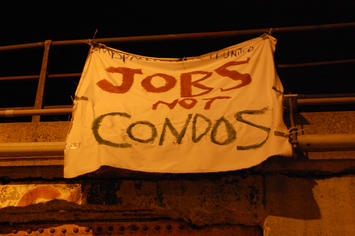
After drifting toward decrepitude since the 1970s, many core cities have experienced real, often bracing, turnarounds. Yet concern is growing that the revitalization of parts of these cities has unevenly benefited some residents at the expense of others. The crucial, and often ignored, question remains whether the policies that have helped spark urban revivals have improved conditions for the greatest number of residents. In a new study for the Center for Opportunity Urbanism, we found that, in most cities, unbalanced urban growth has exacerbated class divisions, while doing little to address the decline of middle-class households. Our analysis, which puts special focus on the urban cores of Chicago, Los Angeles, and Dallas, shows that the once-rapid growth of urban cores and their surrounding neighborhoods has slowed dramatically; net domestic outmigration, according to Census estimates, has increased from 10,000 in 2012 to 440,000 in 2017. At the same time, some of the most actively gentrifying areas, such as San Francisco, Portland, and Seattle, have become increasingly plagued with social dissolution and rising homelessness.
In recent years, a relatively small downtown population has done better, but surrounding areas have not. Philadelphia’s central core rebounded between 2000 and 2014, but for every district that gained in income, two suffered income declines. Research by urban analysts Joe Cortright and Dillon Mahmoudi shows that the number of high-poverty (more than 30 percent below the poverty line) neighborhoods in the U.S. has tripled in the last half-century, from 1,100 in 1970 to 3,100 in 2010.
Poverty is not, as is widely suggested, now primarily a suburban problem. The poverty rate, according to the American Community Survey, remains two-thirds higher in urban cores than in suburbs. Equally important, many longstanding middle- and working-class neighborhoods are disappearing. Teachers, firemen, and police officers are struggling to afford homes in many American cities, according to a study from Trulia. This pricing-out also applies to many skilled blue-collar professions like technicians, construction workers, and mechanics.
Read the entire piece at City Journal.
Joel Kotkin is executive editor of NewGeography.com. He is the Roger Hobbs Distinguished Fellow in Urban Studies at Chapman University and executive director of the Houston-based Center for Opportunity Urbanism. His newest book is The Human City: Urbanism for the rest of us. He is also author of The New Class Conflict, The City: A Global History, and The Next Hundred Million: America in 2050. He lives in Orange County, CA.
Wendell Cox is principal of Demographia, an international public policy and demographics firm. He is a Senior Fellow of the Center for Opportunity Urbanism (US), Senior Fellow for Housing Affordability and Municipal Policy for the Frontier Centre for Public Policy (Canada), and a member of the Board of Advisors of the Center for Demographics and Policy at Chapman University (California). He is co-author of the "Demographia International Housing Affordability Survey" and author of "Demographia World Urban Areas" and "War on the Dream: How Anti-Sprawl Policy Threatens the Quality of Life." He was appointed to three terms on the Los Angeles County Transportation Commission, where he served with the leading city and county leadership as the only non-elected member. He served as a visiting professor at the Conservatoire National des Arts et Metiers, a national university in Paris.
Photo: Eric Allix Rogers, via Flickr, using CC License.













No Politics?
The reporters avoid--perhaps studiously?--any mention of politics, but nearly all of the cities cited are controlled--and incontestably so--by Democrats/Blue politics. And not only the cities; the states they are in as well. So it seems a not-impertinent question to ask how it is that a politics that shouts "inequality" at every opportunity does not, in those areas under its firm command, actually "solve the problem" (because government as solver of problems is another axiom of Blue politics and also "centrist" (in quotes because I deny any such thing currently exists) managerial-technocratic-administrative-policy expert types).
The tax base is there, in those Blue cities and states, for AOC-inclining redistribution. The Blue will is, one presumes, there, for aggressive regulations that positively prohibit renting or purchase of housing by one or more defined classes of persons or that take property from some and build public housing or "affordable housing" directly. Etc.
Excusing action at the city and state level by reference to "problems that by their nature can only be solved at the national level" is just that--excuse making.
Blue states could massively increase their tax revenues tomorrow, if they so chose, and redistribute the money to alleviate the inequality. Nothing stops them from installing mini-Green New Deals and/or mini-Warren forfeitures. Nothing, that is, except their wealthy donor base, who want to keep their wealth with no less avidity than the most stereotypical, mythical Republican.
Why don't Blue states and cities implement the very policies in their own jurisdictions that they condemn Republicans for preventing at a national level? Why is this aspect of the whole situation not more frequently commented on by "centrists" like Kotkin (which is what I take him to take himself to be)?